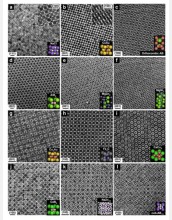|

Press Release 06-005
A New Family of Self-Assembling Nanolattices

January 5, 2006
Inspired by the way most solids form in nature, with free-floating molecules spontaneously assembling themselves into a rigid, highly uniform array, researchers from Columbia University and IBM have learned how to create a whole new family of intricate structures out of artificial nanoscale crystals.
Because the nanocrystals can be chosen for their precise magnetic and electronic properties, says the group's spokesperson, Stephen O'Brien of Columbia, these new structures could have broad application for magnetic storage and nanoscale electronics.
"You can think of nanocrystals as building blocks like the toy Lego," says O'Brien, "in which a larger structure can be assembled by locking in the pieces according to their shape and the way they prefer to join to each other. Except all of this is on an incredibly small length scale -- billionths of a meter."
The group described 10 of the new structures in the Jan. 5, 2006, issue of the journal Nature. Their work was supported by the National Science Foundation (NSF) and the New York State Office of Science, Technology and Academic Research through NSF's Materials Research Science and Engineering Center at Columbia.
For more information, see the Columbia University news release.
-NSF-

Media Contacts
M. Mitchell Waldrop, NSF (703) 292-7752 mwaldrop@nsf.gov
Alex Lyda, Columbia University (212) 854-5276 mal2133@columbia.edu
Principal Investigators
Stephen O'Brien, Columbia University (212) 854-9478 so188@columbia.edu
Related Websites
Columbia University news release: http://www.columbia.edu/cu/news/06/01/superlattice.html

The National Science Foundation (NSF) is an independent federal agency that supports fundamental research and education across all fields of science and engineering. In fiscal year (FY) 2009, its budget is $9.5 billion, which includes $3.0 billion provided through the American Recovery and Reinvestment Act. NSF funds reach all 50 states through grants to over 1,900 universities and institutions. Each year, NSF receives about 44,400 competitive requests for funding, and makes over 11,500 new funding awards. NSF also awards over $400 million in professional and service contracts yearly.
 Get News Updates by Email Get News Updates by Email
Useful NSF Web Sites:
NSF Home Page: http://www.nsf.gov
NSF News: http://www.nsf.gov/news/
For the News Media: http://www.nsf.gov/news/newsroom.jsp
Science and Engineering Statistics: http://www.nsf.gov/statistics/
Awards Searches: http://www.nsf.gov/awardsearch/
| 

